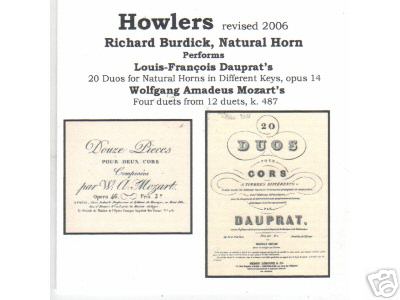 CD16
CD16
Howlers
revised 2006
Richard Burdick, natural performs
Dauprat Duets, opus 14 & some Mozart
The story behind the revision:
After Mr. Burdick completed two cd’s of his own compositions,
he recorded the Dauprat duets.
The first version of Howlers (2002) was done on borrowed horns
under the assumption that (maybe) these duets could be played on
natural horn. The title implies, like a dog’s response to
bad intonation, the music isn’t very well in tune.
There was always the feeling of costs going too high in a rented
studio &
not enough time for fixes.
Just four years later and hundreds of hours of natural horn recording
time under his belt, Richard needed an easy project to test out
his new studio in his new house in Regina, Saskatchewan. What was
almost impossible in 2002 is now an easy project.
This recording was done at the tempos that Dauprat suggested, many
faster than before, one exactly the same and a few slower.
The Mozart selections are a teaser for a later release of an all
Mozart CD. Bear in mind that it is most likely that Mozart wrote
these while bowling with Leutgeb and fooling around to find the
limits of his horn playing ability. They most likely were for Eb
horn, even though the go up to the 24th overtone.
The Dauprat duets, opus 14 are for horns in different keys. His
is not the sort of composer who modulated very much. The pair of
different keyed horns play the same melody but on a different set
of overtones, and with different hand positions in the bell. It’s
very interesting. Mozart did this sort of thing in his more complex
works, like his 40th Symphony with horns in G &
Bb alto together.
In the Dauprat duets he goes step by step through the major & minor
keys that are possible on the horn with all its crooks, done in
a similar way that Bach did in the Well tempered clavier.
Dauprat defended the natural horn: ”Some have wished that
by means of holes and keys the considerable series of factitious
sounds on the horn might be eliminated, while at the same time
and in the same way those that are totally lacking in the low register
would become possible. But this method, already applied to the
[keyed] trumpet, has changed the timbre of the instrument to the
point of giving it a quite peculiar character, creating an instrument
which is neither a trumpet nor any other known instrument. ...
The horn would probably fare likewise were it made to undergo similar
alterations: it would lose its character and the true quality of
its natural and factitious tones. Most of these latter have a charm
that is particularly theirs, and which serve, so to speak, for
shadings and nuances in contrast with the natural sounds. It must
then be presumed that, far from gaining by their complete removal,
the horn would lose a great deal. And what is said here about the
various sounds of the complete range of the instrument must obviously
extend to the different crooks.
Each of these, taken by itself, has its own color, its timbre,
and its special character; but if they were all combined in a single
assembly, becoming but one and the same instrument, this instrument
would certainly have, if you will, the same range of low, high,
and middle sounds. However, the more the new inventions produce
equality among all the sounds, the more the characters, colors,
and timbres of the individual crooks would be distorted and confused.”
REVIEWS